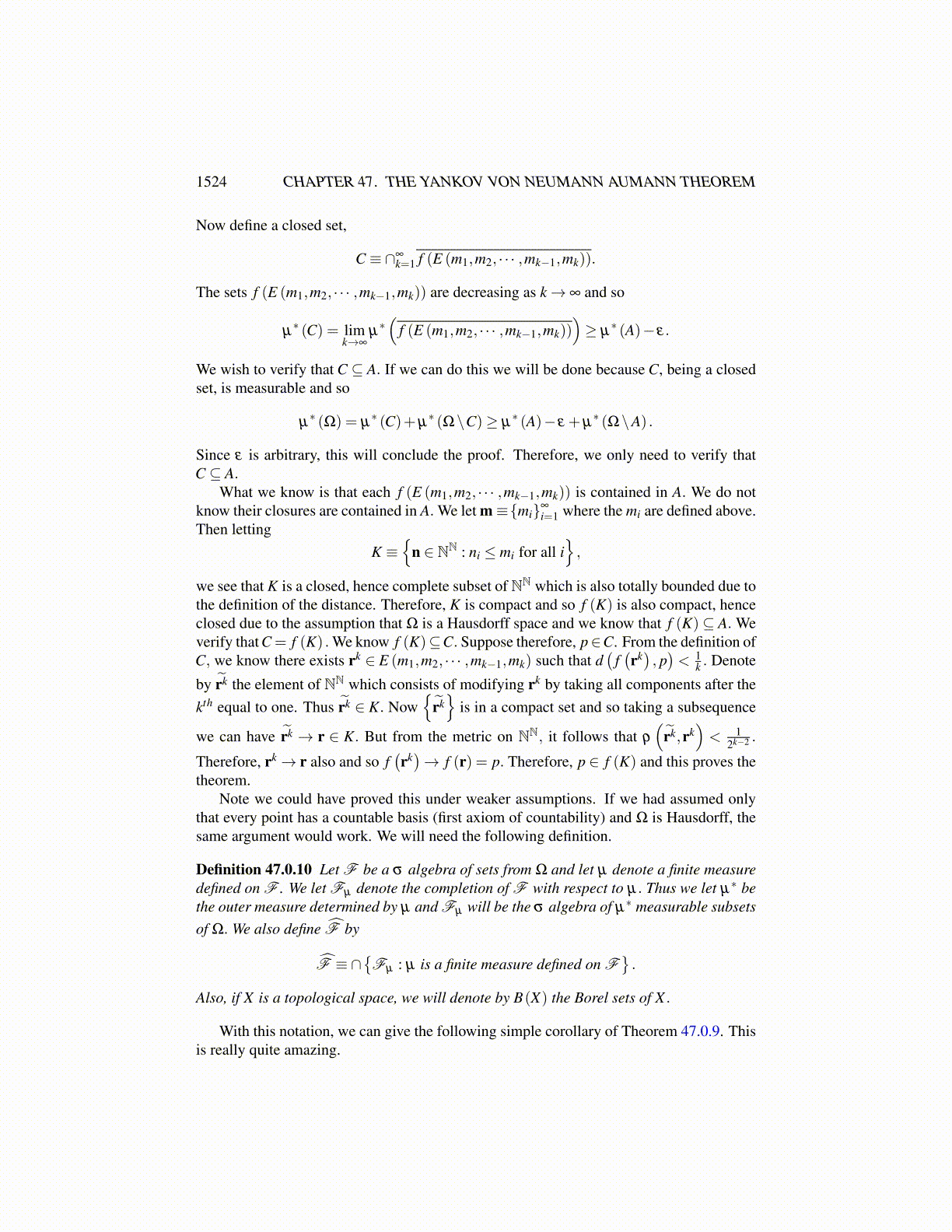
1524 CHAPTER 47. THE YANKOV VON NEUMANN AUMANN THEOREM
Then µ∗ is regular, meaning that for every S, there exists E ∈ F such that E ⊇ S andµ (E) = µ∗ (S) . If Sn ↑ S, it follows that µ∗ (Sn) ↑ µ∗ (S) . Also if µ (Ω)< ∞, then a set, Eis measurable if and only if
µ∗ (Ω)≥ µ
∗ (E)+µ∗ (Ω\E) .
Proof: First we verify that µ∗ is regular. If µ∗ (S) = ∞, let E = Ω. Then µ∗ (S) = µ (E)and E ⊇ S. On the other hand, if µ∗ (S)< ∞, then we can obtain En ∈F such that µ∗ (S)+1n ≥ µ (En) and En ⊇ S. Now let Fn = ∩n
i=1Ei. Then Fn ⊇ S and so µ∗ (S)+ 1n ≥ µ (Fn) ≥
µ∗ (S) . Therefore, letting F = ∩∞k=1Fk ∈F it follows µ (F) = limn→∞ µ (Fn) = µ∗ (S) .
Let En ⊇ Sn be such that En ∈ F and µ (En) = µ∗ (Sn) . Also let E∞ ⊇ S such thatµ (E∞) = µ∗ (S) and E∞ ∈F . Now consider Bn ≡ ∪n
k=1Ek. We claim
µ (Bn) = µ (Sn) . (47.0.1)
Here is why:
µ (E1 \E2) = µ (E1)−µ (E1∩E2) = µ∗ (S1)−µ
∗ (S1) = 0.
Therefore,
µ (B2) = µ (E1∪E2) = µ (E1 \E2)+µ (E2) = µ (E2) = µ∗ (S2) .
Continuing in this way we see that 47.0.1 holds. Now let Bn ∩E∞ ≡ Cn. Then Cn ↑ C ≡∪∞
k=1Cn ∈F and µ (Cn) = µ∗ (Sn) . Since Sn ↑ S and each Cn ⊇ Sn, it follows C ⊇ S andtherefore,
µ∗ (S)≤ µ (C) = lim
n→∞µ (Cn) = lim
n→∞µ∗ (Sn)≤ µ
∗ (S) .
Now we verify the second claim of the lemma. It is clear the formula holds wheneverE is measurable. Suppose now that the formula holds. Let S be an arbitrary set. We needto verify that
µ∗ (S)≥ µ
∗ (S∩E)+µ∗ (S\E) .
Let F ⊇ S, F ∈F , and µ (F) = µ∗ (S) . Then since µ∗ is subadditive,
µ∗ (Ω\F)≤ µ
∗ (E \F)+µ∗ (
Ω∩EC ∩FC) . (47.0.2)
Since F is measurable,µ∗ (E) = µ
∗ (E ∩F)+µ∗ (E \F) (47.0.3)
andµ∗ (Ω\E) = µ
∗ (F \E)+µ∗ (
Ω∩EC ∩FC) (47.0.4)
and by the hypothesis,µ∗ (Ω)≥ µ
∗ (E)+µ∗ (Ω\E) . (47.0.5)
Therefore,
µ (Ω) ≥ µ∗ (E)+µ
∗ (Ω\E)
= µ∗ (E ∩F)+µ
∗ (E \F)+µ∗ (Ω\E)
= µ∗ (E ∩F)+µ
∗ (E \F)+µ∗ (F \E)+µ
∗ (Ω∩EC ∩FC)
≥ µ∗ (Ω\F)+µ
∗ (F \E)+µ∗ (E ∩F)
≥ µ∗ (Ω\F)+µ
∗ (F) = µ (Ω)